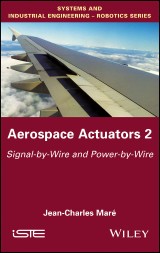Details

Aerospace Actuators 2
Signal-by-Wire and Power-by-Wire1. Aufl.
|
139,99 € |
|
| Verlag: | Wiley |
| Format: | |
| Veröffentl.: | 13.03.2017 |
| ISBN/EAN: | 9781119407195 |
| Sprache: | englisch |
| Anzahl Seiten: | 288 |
DRM-geschütztes eBook, Sie benötigen z.B. Adobe Digital Editions und eine Adobe ID zum Lesen.
Beschreibungen
<p>This book is the second in a series of volumes which cover the topic of aerospace actuators following a systems-based approach.<br />This second volume brings an original, functional and architectural vision to more electric aerospace actuators. The aspects of signal (Signal-by-Wire) and power (Power-by-Wire) are treated from the point of view of needs, their evolution throughout history, and operational solutions that are in service or in development. <br />This volume is based on an extensive bibliography, numerous supporting examples and orders of magnitude which refer to flight controls and landing gear for various aircraft (fixed or rotorwing, launchers) in commercial, private and military applications. <br />The topics covered in this set of books constitute a significant source of information for individuals and engineers from a variety of disciplines, seeking to learn more about aerospace actuation systems and components.</p> <p> </p>
<p>Introduction ix</p> <p><b>Chapter 1. Electrically Signaled Actuators (Signal-by-Wire) 1</b></p> <p>1.1. Evolution towards SbW through the example of the flight controls 2</p> <p>1.1.1. Military applications 2</p> <p>1.1.2. Commercial aircraft 3</p> <p>1.1.3. Helicopters and compound helicopters 5</p> <p>1.2. Incremental evolution from all mechanical to all electrical 9</p> <p>1.2.1. Exclusively mechanical signaling 9</p> <p>1.2.2. Fly-by-Wire 18</p> <p>1.3. Challenges associated with electrical signaling 22</p> <p>1.3.1. Electrical interfaces 22</p> <p>1.3.2. Evolution of the control and information transmission architectures 30</p> <p>1.3.3. Reliability and backup channels 32</p> <p>1.4. The example of landing gears 35</p> <p><b>Chapter 2. Signal-by-Wire Architectures and Communication 39</b></p> <p>2.1. Architectures 40</p> <p>2.1.1. Federated architectures 40</p> <p>2.1.2. Integrated modular architectures 41</p> <p>2.2. Data transmission 43</p> <p>2.2.1. CAN 45</p> <p>2.2.2. RS422 and RS485 46</p> <p>2.2.3. ARINC 429 46</p> <p>2.2.4. MIL-STD-1553B 48</p> <p>2.2.5. ARINC 629 48</p> <p>2.2.6. AS-5643/IEEE-1394b 49</p> <p>2.2.7. AFDX (ARINC 664 Part 7) 50</p> <p>2.2.8. Triggered time protocol (TTP/C) 52</p> <p>2.3. Evolutions in data transmission 53</p> <p>2.3.1. Power over data and power line communication 54</p> <p>2.3.2. Optical data transmission (Signal-by-Light or SbL) 55</p> <p>2.3.3. Wireless data transmission (Signal-by-WireLess or SbWL) 58</p> <p><b>Chapter 3. Power-by-Wire 59</b></p> <p>3.1. Disadvantages of hydraulic power transmission 60</p> <p>3.1.1. Power capacity of hydraulic pumps 61</p> <p>3.1.2. Hydraulic pump efficiency 61</p> <p>3.1.3. Centralized power generation 62</p> <p>3.1.4. Power transmission by mass transfer 62</p> <p>3.1.5. Control of power by energy dissipation 63</p> <p>3.2. Electrical power versus hydraulic power 64</p> <p>3.3. Improving hydraulically supplied solutions 68</p> <p>3.3.1. Reduction of energy losses in actuators 68</p> <p>3.3.2. Increased network power density 70</p> <p>3.3.3. Other concepts 70</p> <p>3.4. Concepts combining hydraulics and electrics 71</p> <p>3.4.1. Local electro-hydraulic generation 71</p> <p>3.4.2. Electro-hydrostatic actuators 73</p> <p>3.5. All electric actuation (hydraulic-less) 81</p> <p>3.5.1. Principle of the electro-mechanical actuator 81</p> <p><b>Chapter 4. Electric Power Transmission and Control 83</b></p> <p>4.1. Electric power transportation to PbW actuators 83</p> <p>4.1.1. Form 84</p> <p>4.1.2. Voltage and current levels 85</p> <p>4.2. Electric motors 91</p> <p>4.2.1. Elementary electric machines 91</p> <p>4.2.2. Conversion of electrical power into mechanical power 95</p> <p>4.3. Power conversion, control and management 98</p> <p>4.3.1. Electric power system of a PbW actuator 98</p> <p>4.3.2. Principle and interest of static switches 100</p> <p>4.3.3. Groups of switches: commutation cell, chopper and inverter 103</p> <p>4.3.4. Inverter command 105</p> <p>4.3.5. The power architecture of a PbW actuator 113</p> <p>4.4. Induced, undergone or exploited effects 115</p> <p>4.4.1. Dynamics in presence 115</p> <p>4.4.2. Torque ripple 118</p> <p>4.4.3. Energy losses 119</p> <p>4.4.4. Impact of concepts and architectures on performances 124</p> <p>4.4.5. Reliability 127</p> <p>4.5. Integration 130</p> <p>4.5.1. Overall integration of the actuator 130</p> <p>4.5.2. Cooling 133</p> <p>4.5.3. Mechanical architecture of motor control/power electronic units . 135</p> <p><b>Chapter 5. Electro-hydrostatic Actuators 139</b></p> <p>5.1. Historical background and maturing of EHAs 139</p> <p>5.1.1. PbW actuators with variable displacement pump (EHA-VD) 139</p> <p>5.1.2. Fixed displacement and variable speed EHA actuators 145</p> <p>5.2. EHA in service and feedback 159</p> <p>5.3. EHA specificities 161</p> <p>5.3.1. Pumps 161</p> <p>5.3.2. Filling and charging 163</p> <p>5.3.3. Dynamic increase of mean pressure (pump-up) 164</p> <p>5.3.4. Energy losses and thermal equilibrium 164</p> <p>5.3.5. Dissymmetry 168</p> <p>5.3.6. Control 169</p> <p><b>Chapter 6. Electro-mechanical Actuators 171</b></p> <p>6.1. Development and operation of electromechanical actuators 172</p> <p>6.1.1. Space launchers 173</p> <p>6.1.2. Flight controls 179</p> <p>6.1.3. Landing gears 185</p> <p>6.1.4. Helicopters 191</p> <p>6.1.5. Application to engines 194</p> <p>6.2. Specificities of EMAs 195</p> <p>6.2.1. Power architectures 196</p> <p>6.2.2. Power management functions 203</p> <p>6.2.3. Jamming 206</p> <p>6.2.4. Breakage 212</p> <p>6.2.5. Thermal equilibrium 214</p> <p>6.2.6. Control 214</p> <p>6.2.7. Further considerations 217</p> <p>Bibliography 219</p> <p>Notations and Acronyms 235</p> <p>Index 245</p>
<strong>Jean-Charles Maré</strong>, National Institute of Applied Sciences (INSA), France.
Diese Produkte könnten Sie auch interessieren:

Turbulent Drag Reduction by Surfactant Additives

von: Feng-Chen Li, Bo Yu, Jin-Jia Wei, Yasuo Kawaguchi

156,99 €

Turbulent Drag Reduction by Surfactant Additives

von: Feng-Chen Li, Bo Yu, Jin-Jia Wei, Yasuo Kawaguchi

156,99 €














